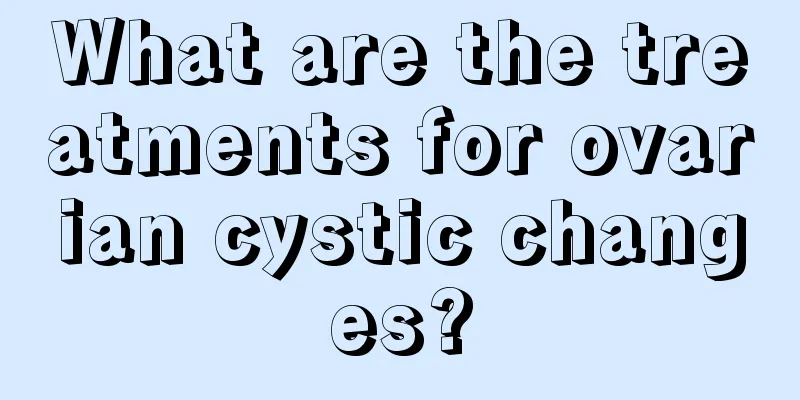What are the treatments for ovarian cystic changes?

|
As we all know, women have higher levels of estrogen in their bodies, but because of abnormalities in the endocrine system, a large amount of androgen may be secreted, which can cause ovarian cystic changes in women. At this time, many symptoms will appear, such as menstruation will become irregular, and women's skin will easily grow hair like men, etc. How to treat it at this time? First, symptoms of ovarian cystic changes Symptoms of ovarian cystic change include menstrual disorders, amenorrhea, anovulation, hirsutism, obesity, infertility and bilateral ovarian enlargement with cystic changes. Patients may have the above typical symptoms, or only some of them, but infertility due to ovulation disorders is the main clinical manifestation of polycystic ovary syndrome. Many patients with ovarian cystic changes have hyperinsulinemia. Patients with hyperinsulinemia are prone to diabetes and cardiovascular and cerebrovascular diseases. Therefore, polycystic ovary syndrome is also a high-risk factor for diabetes and cardiovascular and cerebrovascular diseases. Polycystic ovary syndrome is one of the symptoms of ovarian cysts. Affects appearance, infertility, metabolic abnormalities, menstrual disorders, obesity and hirsutism, etc. Second, treatment Ovarian cystic changes can lead to female infertility, which is a big blow to many female friends who want to have babies, so ovarian cystic changes must be discovered and treated in a timely manner. The current treatment for ovarian cystic changes is drug therapy, but the effect is relatively slow, unlike hormone drugs that will cause dependence. Surgical treatment is effective, and this is the most effective treatment for ovarian cystic changes. Third, Definition It is a terminal ovarian pathological change caused by dysfunction of multiple endocrine axes. The initial neuroendocrine changes are increased release frequency and pulse amplitude of luteinizing hormone and gonadotropin, and increased ratio of luteinizing hormone to follicle-stimulating hormone. Ovarian cystic change is a type of ovarian tumor, which may be benign or malignant. Therefore, after discovering ovarian cystic change, we must first confirm whether it is benign or malignant. It should be noted that sometimes the ovaries appear to have changes like cysts, but they are not cysts, such as polycystic ovaries, corpus luteum cysts, endometriosis in the ovaries, etc. Although these diseases will also cause lumps on the ovaries, it is recommended that you go to the hospital for a detailed examination to clarify the nature of the ovarian cystic change and provide targeted treatment. |
<<: How to adjust diet for breast hyperplasia?
>>: What are the symptoms of ovarian atrophy?
Recommend
What are the benefits of olive oil for women?
Olive oil is a common cooking oil in our lives. B...
Precautions before medical abortion
Today's medical technology is very advanced. ...
Can an ectopic pregnancy be treated with abortion?
For most women, ectopic pregnancy is definitely a...
Is it painful to have a normal birth or a caesarean section? It turns out this is the case
Is it more painful to have a natural birth or a c...
What is the difference between a 20 yuan juicer and a 2,000 yuan blender? Is it true that the more expensive, the better?
When it comes to fruit, everyone knows that it is...
What is the nutritional value of stinky tofu? Is stinky tofu high in calories?
Stinky tofu is one of the most distinctive tradit...
Miscarriage at 10 weeks of pregnancy
It is very common for women to have abortions, bu...
What are the symptoms of female genital herpes
Nowadays, people have become more open to sex as ...
How long does it take to drain the lochia after childbirth?
It has been half a month since I had a caesarean ...
How to fade acne marks
Many beginners don’t know much about the skin smo...
"Expert Consensus on Grading Detection of New and Emerging Respiratory Infectious Pathogens" released
Recently, the "Expert Consensus on Grading D...
Is it normal for pregnant women to have a slightly higher glucose tolerance for 2 hours?
Pregnant women can only give birth to healthy bab...
Are there any side effects to long-term use of essential oils?
There are many types of essential oils on the mar...
What causes postpartum pelvic inflammatory disease?
Many pregnant mothers are very prone to pelvic in...









